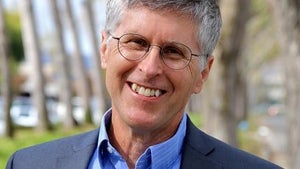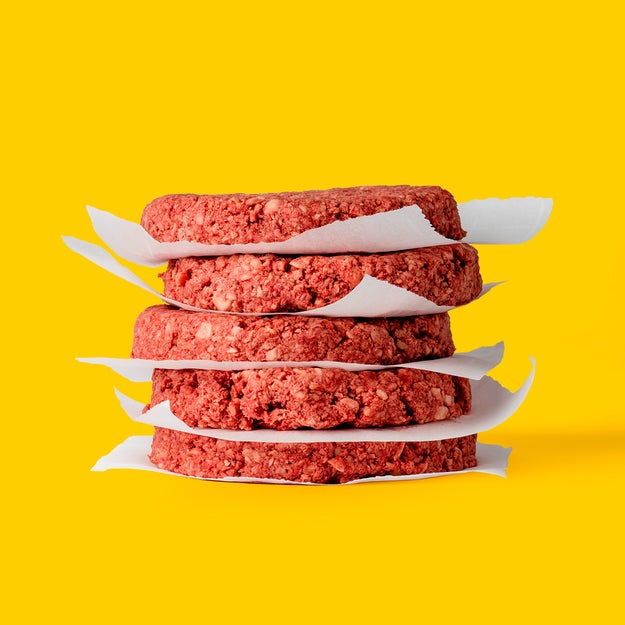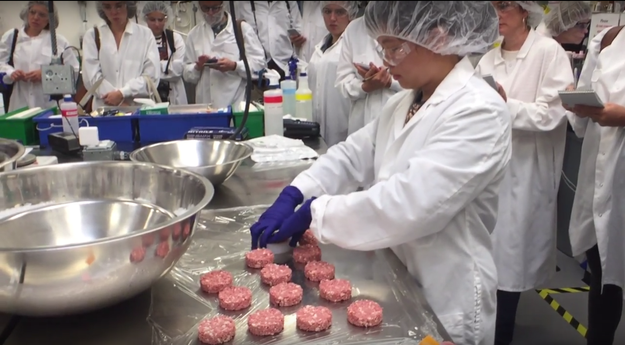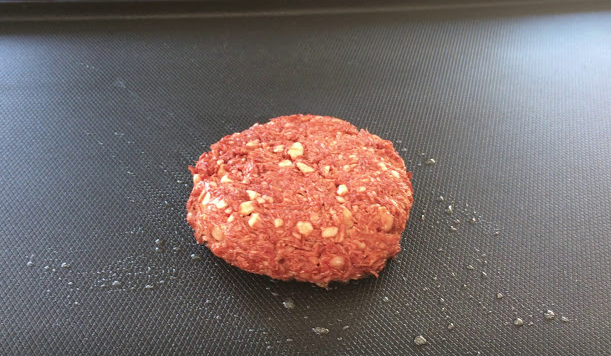
The "blood" is actually heme, a iron-based molecule Impossible Foods derives from soy plants.
Jess Misener / BuzzFeed
Six years ago, Dr. Pat Brown was a scientist on sabbatical. The Stanford University biochemist had built a career out of studying how genes are expressed in cancer, invented microchips that dramatically expanded the scale and possibilities of genetic research, and held prestigious titles such as Howard Hughes Medical Investigator and National Academy of Sciences member.
But during his break, Brown decided he wanted to focus his energy outside academia and tackle what he called “the most important problem in the world I thought I could have an impact on”: animal-based food. Brown, a vegan, thought that meat and dairy placed an undue burden on natural resources from land to water, and that plant-based alternatives, if done correctly, could be more sustainable — and, perhaps, equally tasty.

Dr. Pat Brown, founder and CEO of Impossible Foods.
Impossible Foods
Brown ended up leaving his “dream job” at Stanford for a new workplace he founded himself in 2011: Impossible Foods, a 130-employee vegan food startup whose first product is the meatless, meat-like Impossible Burger. After debuting at David Chang’s Momofuku Nishi in New York City in July, the company said today that, starting Thursday, the burger will be on the menu of three upscale California restaurants: Jardinière and Cockscomb in San Francisco, and Crossroads Kitchen in Los Angeles.
It’s not a Tofurkey-style, mashed-up vegetable kind of patty. Ingredients include water, wheat, coconut oil, soy and potato proteins, and a proprietary broth of amino acids and sugars. The key component, which the company says is the subject of several pending patents, is heme — an iron-containing molecule that can be extracted from the roots of nitrogen-fixing plants such as soybeans. (It’s also what makes your blood red, and the burger pink.)
“Animals are really, if you think about it, just a technology for transforming plants in meat, fish, and dairy foods,” Brown, who is Impossible Foods’ CEO and founder, told reporters recently. “They didn’t evolve for that function and they’re really not very good at it. We had the opportunity to take a fresh look at that problem and say, ‘OK, if you were in 2016 trying to come up with the best possible way to make these foods sustainably, affordably, scalably delicious and optimized for nutrition and so forth, how would you do it?’ Well, the last thing you would probably ever think of is ‘let’s just put plants into animals and kill them and eat them.’”

Impossible Foods
The goal is not necessarily to appeal to vegetarians, but to carnivores who like the taste of meat yet, for health or environmental reasons, are inclined to give up or cut back. Brown claims that, compared to a burger from cows, the Impossible Burger uses 95% less land and 74% less water, and emits 87% fewer greenhouse gases. It also lacks antibiotics, carbohydrates, artificial flavors, and hormones, and derives its fat from coconut oil, according to the company.
“People around the world love meat, fish, and dairy foods,” Brown said. “They’re really not going to stop eating them, and in fact, the demand for those foods has gone through the roof.”
The patties are cranked out at Impossible Foods’ lab, which reporters were recently invited to tour. Here, white-coated PhDs spend their days obsessing over the molecules that make up the texture, flavor, color, and smell of meat. How do you duplicate the experience of turning a patty red to brown on a grill? How do you make sure it’s moist and tough, but not too moist and tough?

Stephanie M. Lee / BuzzFeed News
For BuzzFeed’s lifelong vegetarian tester, who doesn’t enjoy the taste of meat and has never eaten a “real” hamburger, the Impossible burger was viscerally unappetizing. In taste and texture, the burger’s resemblance to real meat was so strong that eating it stirred up a weird cognitive dissonance. But from a carnivore’s perspective, it was very close to the real thing, dense and chewy, although it was a bit softer and more prone to fall apart than is usually the case with burgers.
While these questions require complex problem-solving in molecular biology and biochemistry, the company, which is headquartered in Silicon Valley (an office park in Redwood City, to be precise), also has a strong connection to the tech world. Its $182 million in funding comes from Khosla Ventures, Bill Gates, and Google Ventures, as well as Hong Kong tycoon Li Ka-Shing’s Horizons Ventures, UBS, and Viking Global Investors. Google even tried to buy Impossible Foods for $200 to $300 million, The Information reported in 2015, but the deal fell through because the startup wanted more money.
As Impossible Foods tries to take a swing at animal-based agriculture, it’s not alone. Other rivals are growing animal cells into cultured meat to be used in the future for food or clothing. (Brown said this process, compared to Impossible’s, is much more difficult and labor-intensive on a big scale.) And Beyond Meat, a Los Angeles competitor, has a few years’ head start in selling plant protein-based beef and chicken strips and ground beef in grocery stores nationwide. This year, it’s starting to sell its own plant-based Beyond Burger (which has different ingredients, not including heme) in grocery stores rather than restaurants. Brown says Impossible Foods is entering restaurants first in an attempt to introduce the product to as many people as possible.

The Impossible Burger.
Stephanie M. Lee / BuzzFeed News
Impossible Foods next wants to work on chicken, pork, fish, and dairy products. One potential challenge for those, and for the current product, is costs of production, since the company is still getting off the ground. The burger (with fries or chips) will be $18 at Jardinière, $20 at Cockscomb, and $14 at Crossroads Kitchens — prices clearly targeted at an upscale clientele.
Brown says that while the company profitably sells an Impossible Burger at a cost equal to that of organic, grass-fed ground beef right now, it projects that the cost will drop to or below that of its mass-market equivalent (currently averaging $3.65 a pound nationwide) in two to three years and still be profitable. But that’s provided that Brown sells as many burgers as he thinks he can, and increases the manufacturing process accordingly without sacrificing quality. To scale up, “there’s no discoveries, inventions, breakthroughs required, just smart engineering required — and money, because producing any physical substance at a very large scale, to some degree it’s capital-intensive,” he said.
In the meantime, he’ll be waiting to see if customers bite.

Dat sizzle though. (The white chunks are pieces of coconut oil.)
Jess Misener / BuzzFeed
from BuzzFeed - Tech https://www.buzzfeed.com/stephaniemlee/impossible-foods-meatless-burger-that-bleeds?utm_term=4ldqpia
No comments:
Post a Comment